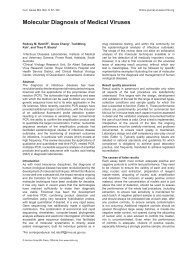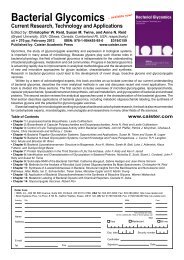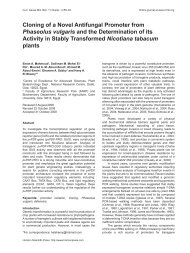Molecular Diagnostics of Medically Important Bacterial Infections
Molecular Diagnostics of Medically Important Bacterial Infections
Molecular Diagnostics of Medically Important Bacterial Infections
You also want an ePaper? Increase the reach of your titles
YUMPU automatically turns print PDFs into web optimized ePapers that Google loves.
26 Millar et al.<br />
drying process. Therefore it is important to give careful<br />
consideration to what one wishes to achieve from a<br />
molecular assay and thus careful emphasis must be<br />
placed on the target gene locus.<br />
Universal gene targets<br />
Ribosomal RNA<br />
Where there is no indication regarding the identity <strong>of</strong> a<br />
bacterial organism, employment <strong>of</strong> amplification <strong>of</strong> DNA<br />
encoding ribosomal RNA genes in conjunction with DNA<br />
sequencing <strong>of</strong> the amplicon has proven to be valuable<br />
(Patel, 2001; Kolbert and Persing, 1999). In bacteria, there<br />
are three genes which make up the rRNA functionality, i.e.<br />
5S, 16S and 23S rRNA. The 16S rRNA gene has historically<br />
been most commonly employed for identification<br />
purposes (see Table 1), due to it being highly conserved<br />
and having a moderate copy number depending on the<br />
genus. 16S rRNA genes are found in all bacteria and<br />
accumulate mutations at a slow, constant rate over time,<br />
hence they may be used as “molecular clocks” (Woese,<br />
1987). Highly variable portions <strong>of</strong> the 16S rRNA sequence<br />
provide unique signatures to any bacterium and useful<br />
information about relationships between them. Since<br />
16S rRNA molecules have crucial structural constraints,<br />
certain conserved regions <strong>of</strong> sequence are found in all<br />
known bacteria. “Broad-range” PCR primers may then<br />
be designed to recognize these conserved bacterial 16S<br />
rRNA gene sequences and used to amplify intervening,<br />
variable or diagnostic regions, without the need to know<br />
Table 1. Applications <strong>of</strong> 16S rDNA PCR to identify causal agents <strong>of</strong> bacterial infection.<br />
Infection Clinical specimen<br />
<strong>Bacterial</strong> endophthalmitis Vitreous fluid (VF) and aqueous humour (AH) specimens Therese et al. (1998)<br />
Bloodborne sepsis Blood-EDTA Xu et al. (2003)<br />
Chronic prosthetic hip infection Tunney et al. (1999)<br />
Detection <strong>of</strong> tick infecting bacteria Schabereiter-Gurtner et al. (2003)<br />
Endocarditis Isolate<br />
Heart valve<br />
Blood culture<br />
Blood<br />
Arterio-embolic tissue<br />
Endodontic infections Siqueira et al. (2001)<br />
Febrile episodes in leukaemic patients Ley et al. (1998)<br />
Helicobacter sp. osteomyelitis in an immunocompetent<br />
child<br />
Biopsy <strong>of</strong> bone lesion Harris et al. (2002)<br />
Intra-amniotic infection Amniotic fluid Jalava et al. (1996)<br />
Intra-ocular infection Carroll et al. (2000)<br />
Woo et al. (2003)<br />
Moore et al. (2001b); Goldenberger (1997)<br />
Millar et al. (2001)<br />
Hryniewiecki et al. (2002)<br />
Mueller et al. (1999)<br />
Maxillary sinus samples from ICU patients Westergren et al. (2003)<br />
Meningitis CSF<br />
Blood-EDTA<br />
any prior sequence or phylogenetic information about the<br />
unknown bacterial isolate.<br />
More recently, employment <strong>of</strong> the 16S-23S rRNA<br />
intergenic spacer region has become popular due to its<br />
high copy number and more importantly its high sequence<br />
variability (Gurtler and Stanisich 1996; Shang et al., 2003).<br />
Primers are directed to highly conserved regions <strong>of</strong> the 16S<br />
and 23S rRNA genes and these may either be universal<br />
or specific, targeting a specific genus e.g., Bartonella spp.<br />
(Houpikian and Raoult, 2001), Chlamydia spp. (Madico et<br />
al., 2000), Tropheryma whipplei (Geissdorfer et al., 2001),<br />
Mycobacterium spp. (Roth et al., 2000) and Salmonella<br />
spp. (Bakshi et al., 2002).<br />
Recently, there have been several reports <strong>of</strong><br />
employment <strong>of</strong> the large subunit (23S rRNA) which<br />
have been used to identify bacterial species. Anthony<br />
et al. (Anthony et al. 2000) reported that the 23S rRNA<br />
locus shows more variation between species <strong>of</strong> medical<br />
importance than the 16S rRNA locus. In their study, these<br />
workers designed universal 23S rRNA primers which<br />
allowed them to detect bacterial agents from 158 positive<br />
blood cultures which were identified using a hybridization<br />
assay with specific oligonucleotide probes. These workers<br />
concluded that the accuracy, range and discrimatory power<br />
<strong>of</strong> their assay could be continually extended by adding<br />
further oligonuclotides to their panel without significantly<br />
increasing complexity and cost. Furthermore, the 23S<br />
rRNA gene locus has been used specifically in order to<br />
detect Stenotrophomonas maltophila from patients with<br />
cystic fibrosis (Whitby et al., 2000).<br />
Saravolatz et al. (2003)<br />
Xu et al. (2003)<br />
Nasal polyps. Chronic sinusitis Bucholtz et al. (2002)<br />
Peritonitis CAPD fluid from Culture-negative peritonitis Bailey et al. (2002)<br />
Rat bite fever Blister fluid Berger et al. (2001)<br />
Reactive arthritis Synovial fluid/tissue Cuchacovich et al. (2002)<br />
Septic arthritis Van der Heijden et al. (1999)<br />
Wound infection Wound tissue from venous leg ulcer Hill et al. (2003)





